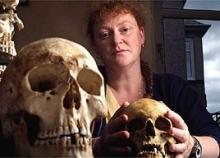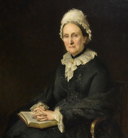
-
Celebrations begin to commemorate 50 years of the University of Dundee
2017 -
The University of Dundee becomes a fully independent institution under the terms of the Royal Charter.
1967 -
Ordinances issued in 1897 made University College form part of St Andrews. and establish a Faculty of Medicine.
1897 -
The Deed formally creating University College Dundee was signed by founders Miss Mary Ann Baxter and her cousin Dr John Boyd Baxter.
1881
Public Art in Dundee
-
date
Fri, 31 Mar 2017
-
Running Time
00:05:27
Dundee has welcomed innovative and exciting public art projects, ensuring that art can be enjoyed by everyone in the city. Nobody has yet done a complete count, but there are now thought to be well over 300 artworks in public spaces around Dundee.
Episode Transcript
I’m Professor Sue Black and welcome to the University of Dundee and our weekly look at the moments in history – both of the institution and the city – that have created the vibrant, dynamic place that we’re now part of. As we celebrate the 50th anniversary of the University becoming independent, we examine the people, discoveries and decisions that have brought us to 2017 as Scotland’s University of the Year and one of the world’s Top 200 universities, delivering teaching and research that is helping to transform lives across society.
Over the last four decades, Dundee has become renowned for its innovative and exciting public art projects, ensuring that art can be enjoyed by everyone in the city. Nobody has yet done a complete count, but there are now thought to be well over 300 artworks in public spaces around Dundee, and some of these were part of a pioneering initiative that would bring the city international attention.
Recognising the potential of culture to spearhead the city’s economic revival, in 1981 discussions began between artists Liz Kemp and Robert McGilvray and planner Alan Lodge concerning the role of art in a new programme of environmental improvements that had just been approved for the Blackness area of Dundee. As one of the densest areas of industrial activity a century before, Blackness was by then left with dozens of empty, derelict buildings. The Blackness Business Development Area scheme was initiated with more than £2 million to spend on the area. An integral part of this was the Blackness Public Art Programme, a three-year project that was truly revolutionary – artists, architects, planners and engineers working together to create a unified approach to the visual transformation of the area.
Robert McGilvray became co-ordinator of the programme, which became a model of innovative practice that would be copied throughout the country and attracted considerable critical attention locally and internationally. In total, 16 separate projects were completed during the three-year period, including Stanley Bonnar’s Ghost Dog and Shadow Trees at the Brown Street Kennels and Keith Donnelly’s Saltire Award-winning ceramic panels on Bellfield Street. More important than any architectural prize, however, was the success of the project in its original aim – to regenerate the area by attracting new businesses. This success encouraged the local authority to continue the project, expanding it to become the city-wide Dundee Public Art Programme, formally established in 1988.
At the same time, recognising the potential for developing new talent in this field, the Head of Design at Duncan of Jordanstone College, Atholl Hill, initiated a postgraduate course in Public Art & Design. The first of its kind in Britain, it was run for many years by Ronald Forbes, who served along with Hill on the Dundee Public Art Programme management group. Students undertook a variety of commissions including mosaics in the Hilltown and sculptures in Upper Dens Works housing complex.
In the 21 years of its existence, the Dundee Public Art Programme created well over 100 works of public art, including David Wilson’s street furniture in the city centre and a set of 25 bronzes on the walls of the Overgate; Alastair Smart and Tony Morrow’s Dundee Dragon on Murraygate; and Diane Maclean’s On the Wing outside Dundee Airport. The long-term future of public art was secured when John Gray, a key member of the programme’s management group, was appointed by the City Council as Public Art Officer. Numerous other distinctive artworks have appeared since, including Panmure Passage by Marion Smith at the waterfront, Dalziel + Scullion’s Catalyst by Greenmarket car park and the much-loved statues of Desperate Dan and Minnie the Minx by Tony and Susie Morrow in the High Street.
More recently, another famous DC Thomson character inspired one of the most popular public art projects ever held in the city, the Oor Wullie Bucket Trail, which saw imaginatively decorated statues of Wullie appear all over the city, all of which were ultimately auctioned off to raise money for Tayside Children’s Hospital at Ninewells. Other imaginative projects recently include the cardboard Royal Arch and luminous birds in the Howff – many more will undoubtedly follow.
Sue Black

Professor Dame Sue Black is Director of the Leverhulme Research Centre for Forensic Science and the Queen's award winning Centre for Anatomy and Human Identification. She was awarded an OBE and DBE for her services to forensic anthropology. Her work has included Governmental deployment to Kosovo during the Balkan Wars, Iraq following the second Gulf War, Grenada, Thailand following the Boxing Day tsunami and most recently to assist with the alleged images of torture relating to the Syrian detention centres. She is a Fellow of the Royal Society of Edinburgh, the Royal Anthropological Institute, the Society of Biology and the Royal College of Physicians of Edinburgh. She has been awarded the Lucy Mair medal for humanitarian work, the Jephcott Gold Medal for her contribution to science and the Fletcher of Saltoun Award for her contribution to Scottish society.
-
Celebrations begin to commemorate 50 years of the University of Dundee
2017 -
The University of Dundee becomes a fully independent institution under the terms of the Royal Charter.
 1967
1967 -
Ordinances issued in 1897 made University College form part of St Andrews. and establish a Faculty of Medicine.
1897 -
The Deed formally creating University College Dundee was signed by founders Miss Mary Ann Baxter and her cousin Dr John Boyd Baxter.
 1881
1881